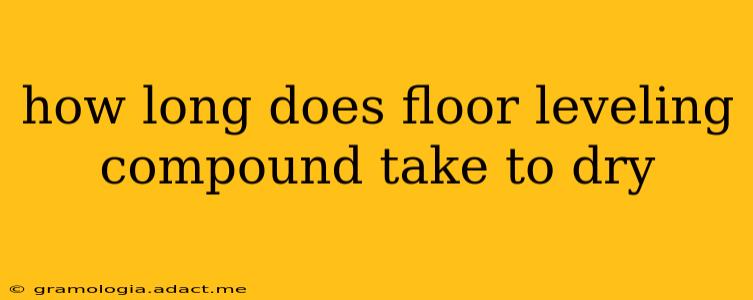Leveling your floor can dramatically improve the look and feel of your home, creating a smooth, even surface perfect for tiling, flooring installation, or simply a more aesthetically pleasing space. But before you start enjoying your newly leveled floors, you need to understand drying times. The drying time for floor leveling compound isn't a simple answer – it depends on several factors. This comprehensive guide will help you understand these factors and provide you with a realistic timeframe for your project.
What Factors Affect Drying Time?
Several factors influence how long your floor leveling compound takes to dry completely. Understanding these will help you manage expectations and ensure a successful project.
-
Type of Compound: Different leveling compounds have different drying times. Self-leveling compounds generally dry faster than those requiring manual spreading, but this can vary between brands and formulations. Check the manufacturer's instructions – they're your best guide. Some compounds are designed for rapid drying, ideal for quick turnaround times, while others are formulated for superior strength and may require longer drying periods.
-
Thickness of Application: Thicker applications obviously take longer to dry than thinner ones. A thin coat might be dry enough for light foot traffic in a few hours, while a thicker application could take days. Always follow the manufacturer's recommendations for maximum thickness per coat.
-
Humidity and Temperature: High humidity slows down the drying process, as the moisture in the air competes with the compound's curing process. Conversely, higher temperatures generally speed up drying. Ideal conditions are usually considered to be moderate temperature and low humidity.
-
Ventilation: Good ventilation helps to accelerate the drying process by removing moisture from the air. Ensure proper ventilation in the room during and after application. Avoid drafts, however, as these can cause the compound to dry too quickly and unevenly.
-
Substrate: The type of surface you're applying the compound to can also influence drying time. Porous surfaces might absorb more moisture, potentially lengthening the drying period.
How Long is "Dry Enough"?
This isn't a simple yes or no answer. There are different levels of dryness to consider:
-
Surface Dry: This usually means the compound is no longer visibly wet or sticky to the touch. This stage may only take a few hours for thin applications, but still doesn't mean the compound is fully cured.
-
Walkable: The compound is firm enough to support foot traffic, but it's crucial that you avoid heavy loads or machinery at this point. Manufacturers typically state when their product becomes walkable on the packaging or in the technical data sheet.
-
Fully Cured: This signifies that the compound has reached its maximum strength and is ready for the next stage of flooring installation, such as tiling or laying new flooring. This usually takes significantly longer than simply being surface dry or walkable. Again, refer to the manufacturer’s specifications for exact times.
How Long Until I Can Install Flooring?
This is perhaps the most crucial question. The manufacturer's instructions are paramount here. Prematurely installing flooring over uncured compound can lead to problems such as cracking, delamination, and ultimately, flooring failure. Don't rush this step! Always allow sufficient drying time to ensure a long-lasting and successful floor installation.
What Happens If It Takes Too Long to Dry?
Extended drying times can sometimes signal a problem. Factors like excessively high humidity or a very thick application may be at play. In some cases, it might be a poorly mixed compound. If you are concerned about drying times exceeding the manufacturer’s recommendations, consult with the product supplier or a flooring professional.
Can I speed up the drying process?
While you can't drastically shorten the overall curing time, you can optimize conditions to encourage faster drying. This includes improving ventilation, maintaining a moderate temperature, and ensuring low humidity within the room. However, avoid using heaters or fans directly blowing on the compound, as this can lead to uneven drying and cracking.
By carefully considering these factors and following the manufacturer's instructions, you'll be well-prepared to successfully level your floor and enjoy your beautiful, even new flooring for years to come. Remember, patience is key! Rushing the process will invariably lead to problems down the road.
